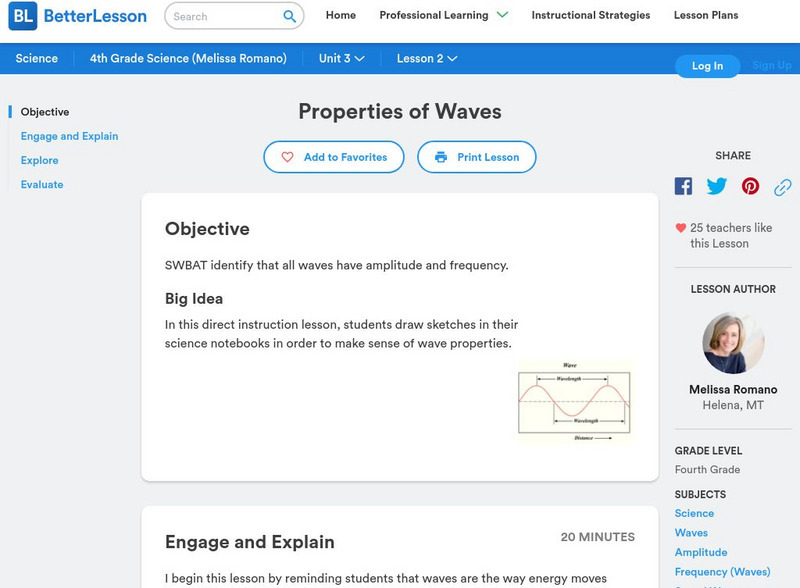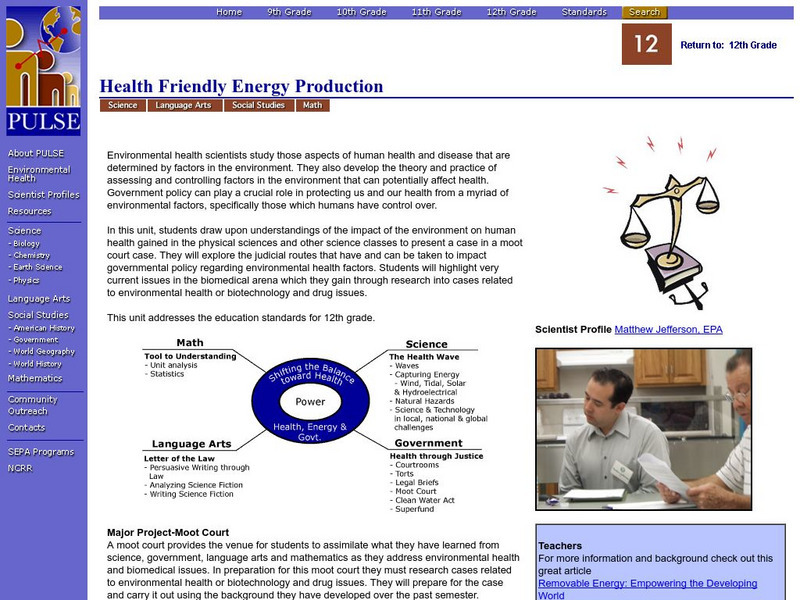Physics Classroom
The Physics Classroom: Wavelike Behaviors of Light
How light waves demonstrate their wave nature by reflection, refraction, and diffraction.
Nobel Media AB
The Nobel Prize: The Nobel Prize in Physics 1929
This site from The Nobel Foundation tells the scientific work which earned Louis de Broglie the Nobel Prize in Physics. Here, you can read the Presentation Speech in which Professor C.W. Oseen praises Louis de Broglie's work and de...
Physics Classroom
The Physics Classroom: Formation of Standing Waves
How are standing wave formations formed? Why are they only formed when the medium is vibrated at specific frequencies? What makes these so-called frequencies so special and magical? These questions are answered in this exploration of...
Physics Classroom
The Physics Classroom: Nodes and Antinodes
In this thorough lesson, nodes and antinodes are explained and compared to crests and troughs. A "Check Your Understanding," set of questions is included at the end of the lesson with answers.
Texas A&M University
Ocean World: Bringing the Ocean to the Classroom
Online resource for students and teachers to see information on icebergs, fisheries, coral reefs, waves, currents and more. Provides teachers with learning activities. Has its own ask-an-expert site (Ask Dr. Bob), and provides real-time...
Vision Learning
Vision Learning: Physics: Waves and Wave Motion
Instructional module focusing on waves and wave motion. Discussion includes wave theories, wave basics, and wave speed. The site also includes an interactive practice quiz and links relating to the topic.
Yale University
Open Yale Courses: Fundamentals of Physics
Intended for students with a strong math and science background, a course introducing physics concepts of Newtonian mechanics, special relativity, gravitation, thermodynamics, and waves. Twenty-four class sessions in video format are...
Michigan Technological University
Michigan Technological University: Up Seis: Seismology and Seismic Waves
Definitions and descriptions of a variety of seismic waves such as S, P, Love, and Rayleigh waves, as well as diagrams and speeds.
University of Colorado
University of Colorado: Physics 2000: Electromagnetic Waves
Using a student-teacher dialogue format, this page discusses the nature of light as an electromagnetic wave and the electromagnetic spectrum.
Physics Classroom
The Physics Classroom: The Nature of a Wave
A very good introduction to the world of waves. Waves and wavelike motion, what is a wave, and categories of waves are the topics examined in this site. Many links to other wave sites.
Physics Classroom
The Physics Classroom: Behavior of Waves
Boundary behavior, incident pulse, reflected pulse,and transmitted pulse are explained in this thorough tutorial. Animation and drawings are used to clarify the concepts.
Other
Transverse and Longitudinal Wave Propagation in an Elastic Medium
Extensive information about how waves behave in an elastic medium. Covers different types of waves, their characteristics and behavior, the anatomy of the ear, the speed of sound in different media, the parts of a wave, and wave phenomena.
University of New South Wales (Australia)
University of New South Wales: School of Physics: Physclips: Travelling Waves I
A learning module exploring travelling waves. Learn about reflections, wave travelling equations, waves on a string, and travelling sine waves with animations and videos.
Better Lesson
Better Lesson: Properties of Waves
In this direct instruction lesson plan, students draw sketches in their science notebooks in order to make sense of wave properties. Resources include a slideshow presentation on the properties of waves and multiple examples of student...
Texas Education Agency
Texas Gateway: Waves: Practical Applications
Given diagrams, scenarios, illustrations, or descriptions, students will identify uses of waves in medical and industrial applications.
PBS
Wnet: Thirteen: Savage Earth: Earthquake!
This animation shows the movement of seismic waves as they moved from Bolivia to San Juan Puerto Rico during a 1994 earthquake.
University of Arizona
Pulse: Health Friendly Energy Production
A cross curricular project where students conduct a moot court to explore the role government policy plays in protecting our health. The focus of the unit is how our power effects our environmental health. Students use their knowledge of...
Center for Innovation in Engineering and Science Education, Stevens Institute of Technology
Ciese: Catch a Wave
In this project for Grades 6 to 12, students will use real data collected online to learn how waves and tides work. They will learn what causes water to move, and how waves and tides impact on humans, organisms and waterfront lands. They...
American Geosciences Institute
American Geosciences Institute: Earth Science Week: Earthquake on the Playground
In this experiment, students go outside and create a simulation of P and S waves traveling across a 30-meter span. This is repeated using a 30-meter square. They experiment with P and S wave behavior, record results, and use...
TeachEngineering
Teach Engineering: Seismic Waves: How Earthquakes Move the Earth
Students learn about the types of seismic waves produced by earthquakes and how they move the Earth. The dangers of earthquakes are presented as well as the necessity for engineers to design structures for earthquake-prone areas that are...
Texas Education Agency
Texas Gateway: Oscillatory Motion and Waves: Problems and Exercises
This is a list of problems and exercises to solve based on the content of Chapter 16: Oscillatory Motion and Waves from the AP Physics online text.
Texas Education Agency
Texas Gateway: Oscillatory Motion and Waves: Conceptual Questions
This is a list of 18 questions covering the major concepts in Chapter 16: Oscillatory Motion and Waves from the AP Physics online text.
Texas Education Agency
Texas Gateway: Oscillatory Motion and Waves: Summary
This page provides a summary for each section of Chapter 16: Oscillatory Motion and Waves from the AP Physics online text.
Texas Education Agency
Texas Gateway: Oscillatory Motion and Waves: Energy in Waves: Intensity
y the end of this section, you will be able to calculate the intensity and the power of rays of sunlight and waves.



















